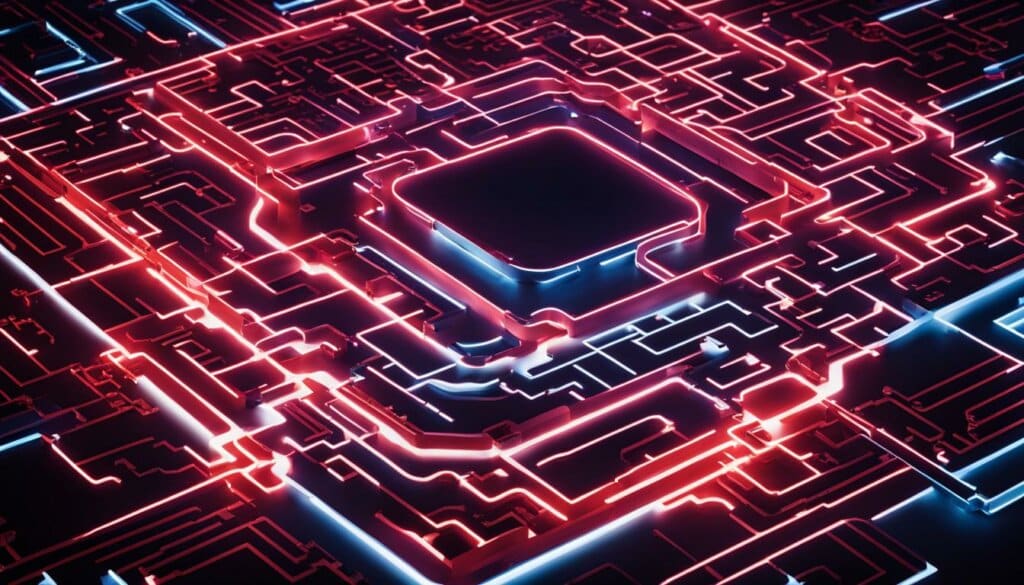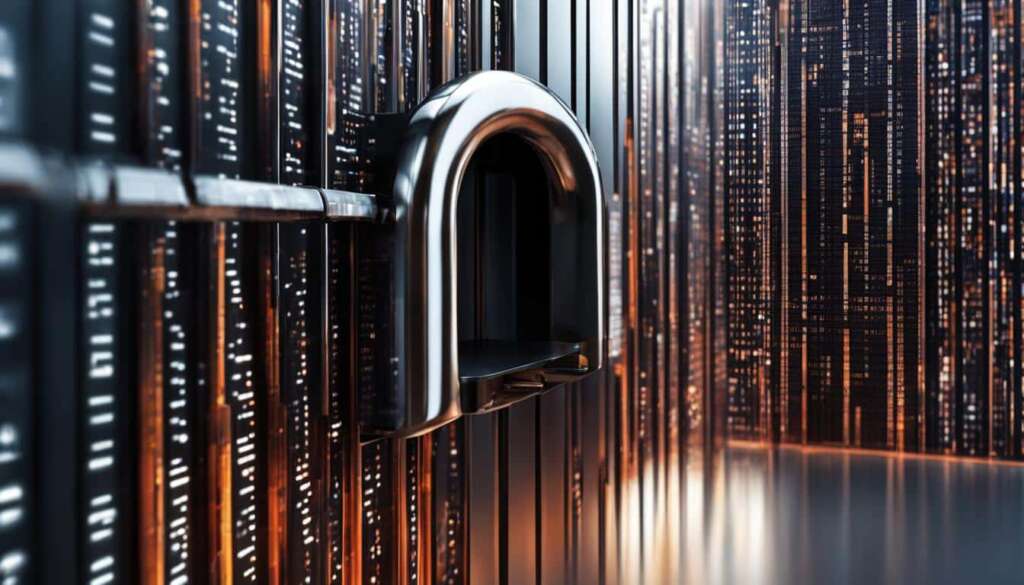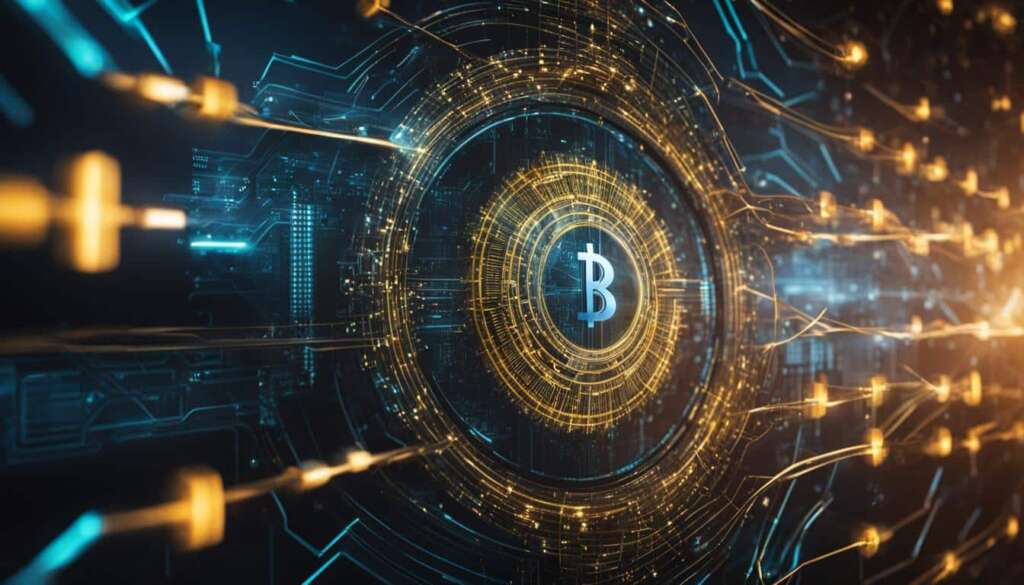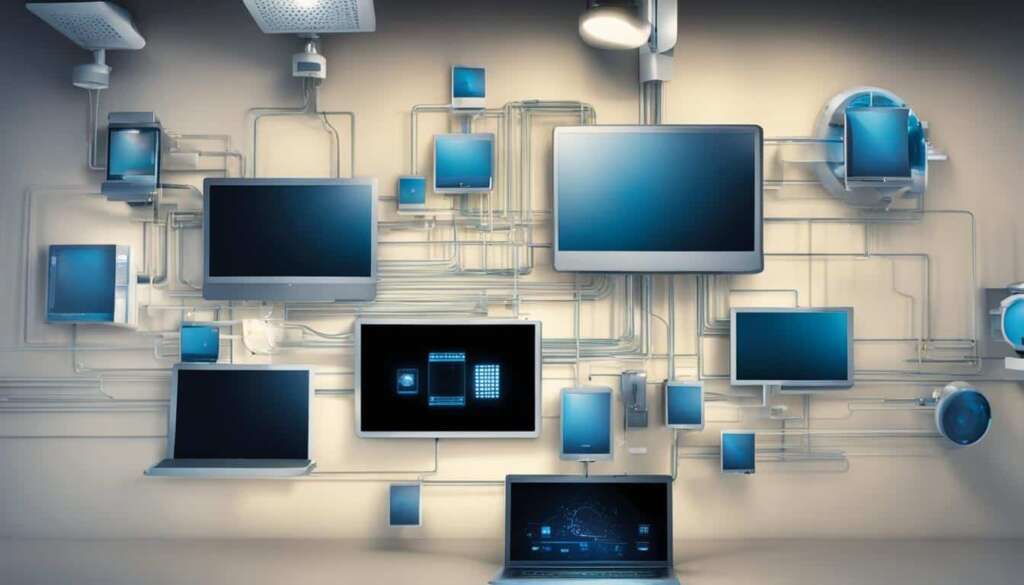Table of Contents
Welcome to our informative article on cybersecurity in 5G networks. As we embrace the advancements of 5G connectivity, it is crucial to address the heightened network security challenges that accompany this new era. With the proliferation of devices and end-user units, the threat landscape expands, necessitating robust measures to safeguard data and protect against potential breaches.
Network security, data protection, threat detection, vulnerability assessment, secure communication, authentication protocols, encryption algorithms, privacy management, and risk analysis are all critical aspects that need to be considered in the realm of 5G cybersecurity.
To illustrate the complexity of this issue, let’s visualize the expanding network disrupting organizations’ operations, emphasizing the need for enhanced security measures. While 5G networks are designed with built-in security features, such as encryption of all traffic and improved authentication protocols, adopting a Zero Trust approach and maintaining continuous vigilance are vital in addressing the evolving cyber risks associated with the shift to 5G.
Stay tuned as we delve deeper into the impact of 5G connectivity on cybersecurity for government agencies, compare the security of 5G with previous wireless technology generations, and explore where agencies should focus their attention to mitigate cyber risks in the shift to 5G. We will also discuss the optimal timing for addressing 5G security concerns and examine the benefits and potential challenges associated with this transformative technology.
Join us on this journey to navigate the complexities of cybersecurity in the age of 5G networks and discover the measures that can be taken to ensure a secure and seamless transition.
How will 5G connectivity affect cybersecurity for government agency IT leaders?
As government agencies prepare for the widespread adoption of 5G connectivity, they must also consider the implications for cybersecurity. With the expansion of 5G networks, the number of devices and end-user units will significantly increase, creating a larger threat landscape. This poses a challenge for IT leaders in government agencies who are responsible for safeguarding sensitive data and ensuring secure communication.
Government agencies need to address the potential cybersecurity risks associated with 5G connectivity. It is crucial for IT leaders to stay updated with the latest developments in network security and threat detection. They should focus on implementing robust vulnerability assessment protocols and adopting secure authentication protocols to prevent unauthorized access to sensitive information.
“The shift to 5G connectivity requires government agencies to be proactive in their approach to cybersecurity, as the expanded network can be more vulnerable to cyber threats.”
Furthermore, government agencies should prioritize the encryption of all traffic on their networks to protect against data breaches. By encrypting data, agencies can ensure that even if it is intercepted, it remains unreadable and unusable to unauthorized parties. IT leaders must also actively manage privacy concerns and conduct continuous risk analysis to identify and address potential vulnerabilities.
| Key considerations for government agency IT leaders: |
|---|
| Stay updated on network security and threat detection |
| Implement robust vulnerability assessment protocols |
| Adopt secure authentication protocols |
| Encrypt all traffic to protect against data breaches |
| Manage privacy concerns and conduct continuous risk analysis |
Is 5G More Secure Than Previous Generations of Wireless Technology?
When it comes to wireless technology, security is a top concern for organizations and individuals alike. With the emergence of 5G networks, there is a natural question that arises: is 5G more secure than previous generations of wireless technology?
The answer is yes. 5G has been specifically designed with security in mind. It incorporates advanced features such as a Zero Trust architecture, encryption of all traffic, and enhanced device and network authentication protocols. These measures significantly bolster the security of 5G networks and make them more resilient against cyber threats.
5G is designed to be more secure than previous generations of wireless technology.
One of the major improvements in 5G security is the implementation of a Zero Trust architecture. This approach assumes that no inherited authentications are trusted and challenges all transactions. By adopting a Zero Trust mindset, organizations can minimize the risk of unauthorized access and mitigate potential security breaches.
In addition to the Zero Trust architecture, encryption of all traffic is now mandatory in 5G networks. This means that all data transmitted over the network is securely encrypted, making it much more difficult for malicious actors to intercept and decipher sensitive information.
Enhanced device and network authentication protocols further enhance the security of 5G networks. These protocols ensure that only authorized devices and users can access the network, reducing the risk of unauthorized access and potential cyber attacks.
Table: Comparison of Security Features in 5G and Previous Wireless Technologies
| Security Feature | 5G | Previous Generations |
|---|---|---|
| Zero Trust Architecture | ✓ | ✗ |
| Encryption of All Traffic | ✓ | ✗ |
| Enhanced Device and Network Authentication Protocols | ✓ | ✗ |
As the table above illustrates, 5G significantly outperforms previous generations of wireless technology in terms of security. Its advanced security features make it a more secure option for organizations seeking robust protection against cyber threats.

In conclusion, 5G is indeed more secure than previous generations of wireless technology. Its implementation of a Zero Trust architecture, encryption of all traffic, and enhanced authentication protocols make it a formidable defense against cyber threats. Organizations can confidently embrace the benefits of 5G connectivity while ensuring the security and integrity of their data and networks.
Where should agencies focus their attention on addressing cyber risks in the shift to 5G?
As government agencies navigate the shift to 5G networks, it is crucial to identify the key areas that require attention to address cyber risks effectively. By focusing on these specific areas, agencies can enhance their cybersecurity posture and mitigate potential threats.
1. Zero Trust Approach
A Zero Trust approach is a fundamental principle that agencies should adopt when transitioning to 5G. This strategy involves assuming no inherited authentications and challenging all transactions, regardless of the source or location. By implementing a Zero Trust framework, agencies can create a secure environment where access is granted based on verified identities and continuous monitoring.
2. Continuous Vigilance
Cyber threats are constantly evolving, and agencies must remain vigilant to stay one step ahead. This requires continuous monitoring, self-scouting, and self-hacking to identify and address vulnerabilities proactively. By regularly assessing their networks and systems, agencies can detect and mitigate potential risks before they are exploited by threat actors.
3. Collaboration with Security Experts
In the ever-changing landscape of cybersecurity, it is essential for agencies to engage with security expertise across the ecosystem. By collaborating with industry-leading experts, agencies can benefit from their knowledge and experience in identifying and mitigating cyber risks specific to the shift to 5G. This collaboration can result in innovative solutions and best practices that enhance overall cybersecurity resilience.
By focusing on a Zero Trust approach, maintaining continuous vigilance, and engaging with security experts, agencies can effectively address cyber risks in the shift to 5G. It is important to prioritize cybersecurity needs regardless of the stage of 5G adoption to ensure proactive risk mitigation and maintain the integrity of critical infrastructure.
When Should Agencies Seriously Address 5G Security?
In order to effectively address the cybersecurity challenges associated with the shift to 5G, it is essential for agencies to take proactive measures today, regardless of their stage of 5G adoption. Waiting until full 5G coverage is achieved may leave organizations vulnerable to potential security breaches and threats. By prioritizing cybersecurity in a 4G environment, agencies can minimize exposure and ensure a smoother transition to 5G.
Most communications service providers are expected to have a standalone network with enhanced 5G features by 2023, and full adoption of 5G is projected to be no later than 2024. These timelines indicate a rapid progression towards widespread 5G implementation, making it crucial for agencies to address their cybersecurity needs as soon as possible.
Adopting a proactive approach allows agencies to assess and enhance their existing security measures, identify potential vulnerabilities, and implement robust risk mitigation strategies. By focusing on 5G security today, agencies can stay ahead of emerging threats and protect the integrity of their networks and data.
Furthermore, addressing cybersecurity in the context of 4G networks provides agencies with valuable insights and experience that can be applied to the unique challenges of 5G technology. This proactive approach ensures that agencies are well-prepared to handle the increased complexity and potential risks associated with the deployment of 5G networks.
The Road to Secure 5G Networks
While 5G technology offers numerous benefits, it also introduces new security challenges for agencies. Some of the key areas that agencies should focus on to address 5G security include:
- Zero Trust Approach: Adopting a zero trust architecture, where all transactions and activities are thoroughly authenticated and validated.
- Continuous Vigilance: Implementing a proactive and continuous monitoring system to detect and respond to potential security threats in real-time.
- Collaboration and Expertise: Engaging with security experts across the ecosystem to gain valuable insights and enhance the overall security posture.
- Enhanced Encryption: Ensuring the encryption of all traffic and leveraging advanced encryption algorithms to protect sensitive data.
- Risk Analysis: Conducting comprehensive risk analysis to identify vulnerabilities and prioritize security measures accordingly.
By focusing on these key areas, agencies can build a strong foundation for secure 5G networks and effectively mitigate potential cybersecurity risks.
| Stage of 5G Adoption | Recommended Action |
|---|---|
| Pre-Adoption | Conduct a thorough assessment of existing security measures and develop a roadmap for 5G security implementation. |
| Early Adoption | Enhance network security controls and establish robust incident response procedures to address emerging threats. |
| Full Adoption | Maintain continuous monitoring and evaluation of security measures, and adapt them to evolving 5G security challenges. |
What is 5G Technology?
5G technology represents the fifth-generation of mobile communications. It offers higher data transfer speeds, lower latency rates, and the ability for connected devices to communicate in real-time. The benefits of 5G extend to household purposes, industrial sectors, edtech, autonomous systems, telemedicine, and precision agriculture.
“5G technology revolutionizes the way we connect and communicate. With its lightning-fast speeds and low latency, we can experience seamless connectivity and faster downloads. This technology opens doors to new possibilities, from smart homes that can be controlled remotely to the autonomous systems that power our transportation. The potential of 5G is immense, and it will shape the future of connectivity.”
One of the key advantages of 5G technology is its ability to support a massive number of connected devices simultaneously. This capacity is essential for the Internet of Things (IoT), where numerous devices need to communicate and exchange data in real-time. With 5G, industries can leverage IoT-enabled technologies for enhanced efficiency, productivity, and automation.
5G technology also plays a crucial role in sectors such as telemedicine, where real-time communication and data transfer are critical for remote healthcare services. With 5G’s low latency and high bandwidth, doctors can remotely diagnose patients, monitor vital signs, and even perform surgeries with the help of robotic systems.

In summary, 5G technology is a game-changer in the world of connectivity. It offers faster speeds, lower latency, and the ability to support a massive number of connected devices. From smart homes to industrial automation, the potential applications of 5G are vast and promising. As we embrace this transformative technology, it is important to address the cybersecurity challenges that arise and ensure the security and integrity of 5G networks.
What are the benefits of 5G technology?
The advent of 5G technology brings with it a host of benefits that will revolutionize our lives and drive economic growth. Let’s explore some of the key advantages:
1. Wider coverage
5G networks offer broader coverage compared to previous generations, ensuring a stronger and more reliable connection in both urban and rural areas. This means that more people, even in remote locations, will have access to high-speed internet and all the opportunities it brings.
2. More stable connections
With 5G, you can say goodbye to dropped calls and buffering videos. The technology provides a more stable and consistent connection, allowing for seamless communication and uninterrupted streaming of high-definition content. This is especially beneficial for teleconferencing, online gaming, and streaming services.
3. Higher download and upload speeds
Gone are the days of waiting for files to download or uploads to complete. 5G networks offer blazing-fast speeds, typically in the range of 10 to 100 times faster than 4G, enabling lightning-fast downloads, ultra-high-definition video streaming, and instant data transfers. This speed boost will transform the way we work, learn, and consume media.
4. Improved performance for smart homes and smart factories
5G technology is a game-changer for the Internet of Things (IoT). It enables millions of interconnected devices to communicate with each other in real-time, paving the way for smart homes and smart factories. With 5G, you can control your appliances, security systems, and energy usage remotely, making your life more convenient and efficient. In factories, 5G-powered IoT devices can optimize production processes, reduce downtime, and increase productivity.
5. Economic growth
The widespread adoption of 5G technology is projected to have a significant impact on the global economy. According to estimates, by 2035, 5G could enable $13.2 trillion of global economic output and support 22.3 million jobs. This growth will come from various sectors, including manufacturing, healthcare, transportation, and entertainment.
In conclusion, 5G technology promises to transform the way we live and work. With wider coverage, more stable connections, higher speeds, improved performance for smart devices, and the potential for significant economic growth, 5G is set to reshape our world.

Geopolitical Fights Associated with 5G Technology
The global race for dominance in 5G technology has sparked a series of geopolitical fights, driven by commercial motives and concerns over national security. At the center of this battle is the Chinese threat, with major world telecom leaders vying to attain the coveted “first mover” advantage in 5G technology. China’s dominance in the 5G market raises concerns about the potential weaponization of this technology and the risk of cyber espionage.
The United States has taken significant measures to counter the dominance of Chinese telecom companies, such as Huawei and ZTE, in the 5G market. These measures include imposing export restrictions, implementing stricter regulations, and encouraging allies to adopt similar policies. By doing so, the United States aims to safeguard its national security interests and protect its critical infrastructure from potential threats posed by Chinese telecom companies.
“The geopolitical fights associated with 5G technology highlight the growing concerns over national security and the response of democratic states. It is imperative for democratic nations to collaborate and jointly tackle the tech challenge posed by authoritarian regimes.”
Democratic states are also striving to collectively address the challenges posed by 5G technology. They are exploring strategies to build secure and resilient networks that prioritize the protection of sensitive data and communication channels. By fostering closer collaboration between countries, industry players, and regulatory authorities, democratic states aim to ensure the security and integrity of 5G networks while preserving their values of openness, transparency, and respect for privacy.
Ultimately, the geopolitical fights associated with 5G technology are a reflection of the high stakes involved in this transformative technology. It is crucial for nations to balance economic interests with national security concerns and work together to establish a global framework that safeguards the benefits of 5G while mitigating potential risks.

Cybersecurity Challenges in 5G Networks
The deployment of 5G networks brings forth new cybersecurity challenges that organizations need to address. With the increasing number of access points and network edges, ensuring security compliance becomes more complex. This complexity introduces uncertainties in the resilience of the network, making it a prime target for threat actors. As a result, protecting critical national infrastructure becomes crucial to safeguard against potential cyberattacks.
One of the key challenges in 5G cybersecurity is the coexistence of 5G networks with previous-generation networks. This compatibility can create vulnerabilities, as older networks may not have the same level of security measures implemented. Furthermore, the proliferation of IoT-enabled devices adds another layer of vulnerability, as these devices may not have robust security protocols in place.
To illustrate the potential impact of these cybersecurity challenges, consider the following table:
| Challenge | Impact |
|---|---|
| Increased attack surface | Greater potential for unauthorized access to networks and data |
| Compatibility issues | Potential vulnerabilities due to the coexistence of 5G with older networks |
| IoT device vulnerabilities | Exploitable security flaws in IoT-enabled devices |
As organizations embrace 5G technology, it is essential to address these cybersecurity challenges proactively. Implementing robust security measures, enhancing network monitoring capabilities, and promoting user awareness and education are key steps in mitigating the risks associated with 5G networks.
Quote:
“The complexity of 5G networks and the coexistence with previous-generation networks introduce new cybersecurity challenges that organizations must address to protect critical infrastructure and data.” – Cybersecurity Expert
What needs to be done to limit the cybersecurity challenges in 5G?
As the deployment of 5G networks continues to expand, it is crucial for organizations and governments to take proactive measures to mitigate cybersecurity challenges. By exploring next-generation technologies, updating policies and security protocols, enhancing end-user awareness, and implementing a comprehensive toolbox of risk mitigation measures, the security and integrity of 5G networks can be safeguarded.
To ensure the resilience of 5G networks, collaboration between countries, industry players, and regulatory authorities is essential. By sharing best practices, intelligence, and expertise, stakeholders can collectively address emerging threats and vulnerabilities. Governments should invest in research and development to stay ahead of cyber threats and develop innovative cybersecurity solutions specific to the 5G ecosystem.
“The integration of 5G into our daily lives brings immense benefits, but it also opens up new attack vectors. It is crucial for all stakeholders to work together to tackle the cybersecurity challenges that accompany this transformational technology.” – Cybersecurity Expert
Additionally, continuous monitoring and auditing of 5G networks are necessary to identify and address any vulnerabilities promptly. Regular risk assessments and penetration tests should be conducted to proactively detect and remediate potential weaknesses. Incident response plans should be established to ensure a swift and coordinated response in the event of a cyber attack.
| Steps to Limit Cybersecurity Challenges in 5G |
|---|
| 1. Explore next-generation technologies to enhance network security. |
| 2. Update policies and security protocols to align with the unique characteristics of 5G. |
| 3. Increase end-user awareness through education and training programs. |
| 4. Implement a comprehensive toolbox of risk mitigation measures. |
| 5. Foster collaboration between countries, industry players, and regulatory authorities. |
| 6. Continuously monitor and audit 5G networks to detect and respond to vulnerabilities. |
The Future of 5G Security
As 5G technology continues to evolve, so too must cybersecurity strategies and measures. Ongoing research and development will be essential to stay ahead of emerging threats and to adapt security protocols to the unique characteristics of 5G networks. Additionally, international collaboration and information-sharing will play a crucial role in addressing global cyber risks associated with 5G.
By prioritizing cybersecurity in the design, deployment, and operation of 5G networks, stakeholders can ensure that the transformative potential of this technology is realized without compromising data security and privacy. With a comprehensive and proactive approach to risk mitigation, the benefits of 5G can be maximized, empowering individuals, organizations, and societies to thrive in the digital age.
Cybersecurity in the age of 5G technology: the EU’s response
The European Union (EU) has recognized the significant cybersecurity challenges posed by the advent of 5G technology and has taken measures to ensure a high level of security in the development and deployment of 5G networks. The EU has launched an action plan and recommendation specifically aimed at addressing these challenges and protecting critical infrastructure.
As part of its approach, the European Commission has called for a concerted EU effort to strengthen cybersecurity in the context of 5G networks. National risk assessments have been conducted by member states, and a report detailing risk scenarios and potential threat actors associated with 5G has been published.
| EU’s Response to 5G Cybersecurity | Status |
|---|---|
| Launch of the EU Action Plan on 5G Cybersecurity | In Progress |
| Publication of the EU Recommendation on Cybersecurity of 5G Networks | Completed |
| National Risk Assessments by EU Member States | Completed |
| Report on Risk Scenarios and Threat Actors Associated with 5G | Completed |
| Development of a Toolbox of Risk Mitigation Measures | In Progress |
| Assessment of the Implementation of the EU Recommendation | Planned |
The EU is currently in the process of developing a toolbox of risk mitigation measures to provide guidance to member states and network operators. Additionally, an assessment of the implementation of the EU recommendation is planned to ensure its effectiveness in addressing 5G cybersecurity concerns.
By taking these proactive steps, the EU aims to safeguard the security and integrity of 5G networks, promoting trust and confidence in the technology. The EU’s response to 5G cybersecurity demonstrates its commitment to ensuring a safe and resilient digital future.
Conclusion
Addressing the cybersecurity challenges in the age of 5G networks is crucial for organizations and government agencies. By adopting a proactive and comprehensive approach, organizations can mitigate the risks associated with this transformative technology. Implementing a zero trust framework, maintaining continuous vigilance, and collaborating with security experts are essential steps in safeguarding 5G networks.
The European Union (EU) has responded to these challenges by launching an action plan and recommendation focused on ensuring a high level of cybersecurity in the development and deployment of 5G networks. National risk assessments have been conducted, and a report on risk scenarios and threat actors has been published, highlighting the EU’s commitment to cybersecurity in the 5G era.
Moving forward, it is imperative that organizations and governments prioritize the security and integrity of 5G networks. By doing so, they can harness the full potential of this technology and create a safer digital environment for all. With proactive measures and collaboration, the cybersecurity challenges of 5G can be effectively addressed, ensuring a resilient and secure future.
FAQ
What security measures should be taken in the age of 5G networks?
Organizations should adopt a proactive and comprehensive approach to risk mitigation, focusing on zero trust, continuous vigilance, and collaboration with security experts.
How will 5G connectivity affect cybersecurity for government agency IT leaders?
5G connectivity increases the number of devices and end-user units, leading to a larger threat landscape. Government agencies need to address the impact of 5G connectivity on cybersecurity and ensure their IT leaders are prepared to mitigate potential risks.
Is 5G more secure than previous generations of wireless technology?
Yes, 5G is designed to be more secure than previous generations. It implements a Zero Trust architecture, encryption of all traffic, and enhanced device and network authentication protocols.
Where should agencies focus their attention on addressing cyber risks in the shift to 5G?
Agencies should focus on adopting a Zero Trust approach, assuming no inherited authentications and challenging all transactions. Continuous vigilance, self-scouting, and self-hacking are also essential. Engaging with security expertise across the ecosystem is crucial.
When should agencies seriously address 5G security?
Agencies should address cybersecurity needs today, regardless of their stage of 5G adoption. It is better to address cybersecurity in a 4G environment to minimize exposure when transitioning to 5G.
What is 5G Technology?
5G technology represents the fifth-generation of mobile communications. It offers higher data transfer speeds, lower latency rates, and the ability for connected devices to communicate in real-time.
What are the benefits of 5G technology?
The benefits of 5G technology include wider coverage, more stable connections, higher download and upload speeds, improved performance for smart homes and smart factories, and economic growth.
What are the geopolitical fights associated with 5G technology?
Geopolitical fights related to 5G technology revolve around commercial motives, the Chinese threat, and the response of democratic states.
What are the potential cybersecurity challenges in 5G?
With the deployment of 5G networks, there is an increased tendency for threat actors to target critical national infrastructure. The complexity of technology introduces uncertainties in the resilience of the network, and the coexistence of 5G with previous-generation networks and IoT-enabled devices create further vulnerabilities.
What needs to be done to limit the cybersecurity challenges in 5G?
To limit the cybersecurity challenges in 5G, it is essential to explore next-generation technologies, formulate a cyber resilience plan, update policies and security protocols, enhance end-user awareness, and implement a comprehensive toolbox of risk mitigation measures. Collaboration between countries, industry players, and regulatory authorities is crucial.
Cybersecurity in the age of 5G technology: the EU’s response?
The EU has launched an action plan and recommendation for the cybersecurity of 5G networks. Member States have conducted national risk assessments, and the EU is preparing a toolbox of risk mitigation measures.
Conclusion
The cybersecurity challenges in the age of 5G networks are significant, but measures can be taken to address them. It is essential to prioritize the security and integrity of 5G networks to harness the full potential of this transformative technology.
Source Links
- https://www.verizon.com/business/resources/factsheets/cybersecurity-in-the-age-of-5g-questions-and-answers/
- https://forumias.com/blog/yojana-may-2023-summary-cybersecurity-challenges-in-the-5g-age/
- https://www.iiea.com/blog/cybersecurity-in-the-age-of-5g-technology-the-eus-response













